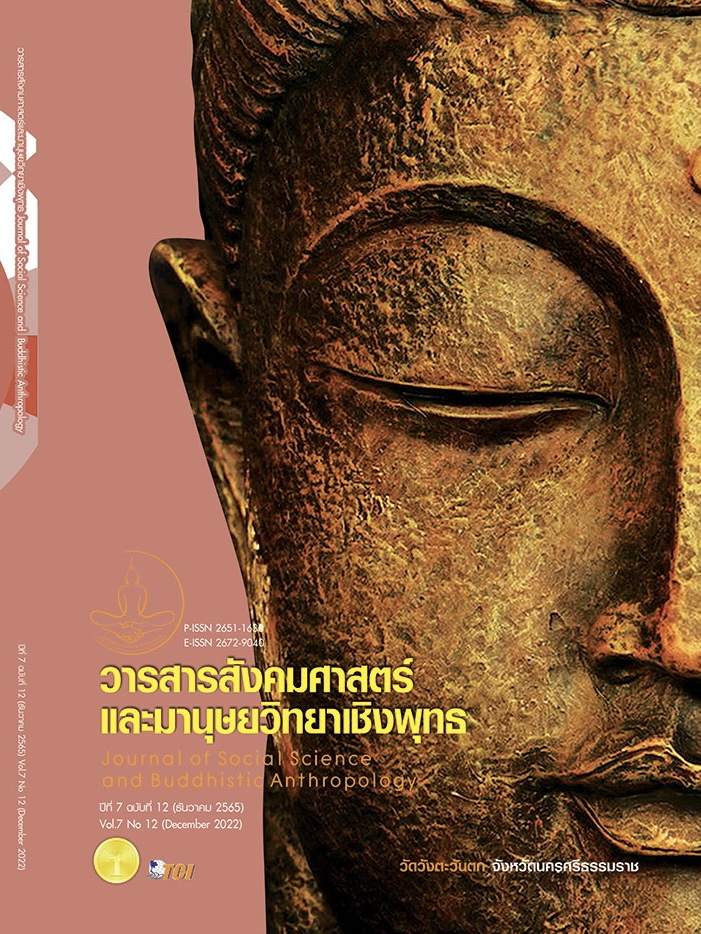MANAGEMENT MODEL OF BUDDHIST OF THAI CULTURAL TOURISM BY PATH OF THE HIGHLY REVERED MONKS IN NAKHON PATHOM PROVINCE
Keywords:
Tourism Management, Buddhism and Culture, Highly Revered MonksAbstract
This research aimed to 1) study tourism management 2) develop a tourism management model. This is a qualitative research by in-depth interviews with key informants, 21 key informants and a focus group discussion 17 scholars and experts, by using contextual content analysis techniques. The research results were found that 1) A study of Buddhist and cultural tourism management following in the footsteps of the monks Nakhon Pathom Province 1.1) tourist incentives Nakhon Pathom was originally a prehistoric community, it has a long history since the Tawadee period 1.2) the attraction of tourist attractions is diverse, each area has different strengths 1.3) types of tourism activities, in addition to being a historical tourist attraction as a source of agricultural production safe industries 1.4) tourism enhancement services 1.5) environmental characteristics of tourist attractions has continued to develop and develop 1.6) tourism marketing promotion and 1.7) recommendations. 2) Development of tourism management model must follow the following steps: Step 1 Integrated Buddhist Tourism Management 1) Dharma Practice for Health 2) Catastrophic Tourism in Samsara 3) Tourism in the Footsteps of Masters Step 2 Preserving Religious Identity 1) Providing knowledge and understanding on religious identity preservation in Nakhon Pathom Province 2) Developing a spiritual way of identity in Buddhism 3) Developing the essence of religious tourism Step 3 Promoting wisdom and morals towards knowledge and Religious Intent 1) Designing in accordance with the needs of tourists 2) Designing a layout of monks and important figures in Buddhism 3) Building a center for promoting wisdom and morals towards the knowledge and intentions of the religion according to the master's footsteps.
References
กฤษดา ขุ่นอาภัย. (2552). การท่องเที่ยวเชิงวัฒนธรรม: กรณีศึกษาบ้านลวงเหนือ ตำบลลวงเหนืออำเภอดอยสะเก็ด จังหวัดเชียงใหม่. ใน วิทยานิพนธ์ศิลปศาสตรมหาบัณฑิต สาขาวิชาเศรษฐศาสตร์การเมือง. มหาวิทยาลัยเชียงใหม่.
ชาชิวัฒน์ ศรีแก้ว. (2554). รัฐธรรมนูญแห่งราชอาณาจักรไทยพุทธศักราช 2540. กรุงเทพมหานคร: สมานการพิมพ์.
ธนิต บุตรทิพย์สกุล. (2558). แนวทางการจัดการการท่องเที่ยวเชิงพุทธศาสนา วัดในพื้นที่ฝั่งธนบุรี. วารสารวิทยาการจัดการปริทัศน์, 21(2), 203-210.
นพวรรณ วิเศษสินธุ์. (2561). ยุทธศาสตร์การท่องเที่ยวเชิงพุทธแบบยั่งยืนจังหวัดปทุมธานี. วารสารบัณฑิตศึกษา มหาวิทยาลัยราชภัฏวไลยอลงกรณ์ ในพระบรมราชูปถัมภ์, 12(1), 70-83.
พรทิพย์ กิจเจริญไพศาล. (2553). การศึกษาทรัพยากรท่องเที่ยวเชิงวัฒนธรรมของชุมชนชาวมอญเพื่อส่งเสริมการท่องเที่ยวเชิงนิเวศในจังหวัดปทุมธานี. ใน วิทยานิพนธ์วิทยาศาสตรมหาบัณฑิต สาขาวิชาการวางแผนและการจัดการการท่องเที่ยวเพื่ออนุรักษ์สิ่งแวดล้อม. มหาวิทยาลัยเกษตร.
สำนักงานวัฒนธรรมจังหวัดนครปฐม. (2556). องค์พระปฐมเจดีย์. เรียกใช้เมื่อ 12 มีนาคม 2565 จาก https://www.m-culture.go.th/nakhonpathom/ewt_news.php?n id=211&filename=index
สุรศักดิ์ ศิลาวรรณา. (2550). การท่องเที่ยวและการเผยแพร่พระพุทธศาสนา: บทบาทของวัดในเขตกรุงเทพมหานคร กรณีศึกษา วัดบวรนิเวศวิหารและวัดเบญจมบพิตรดุสิตวนาราม. ใน รายงานการวิจัย. มหาวิทยาลัยมหิดล.
อารีย์ นัยพินิจ และคณะ. (2556). การศึกษาศักยภาพการท่องเที่ยวเชิงศาสนาของวัดในกลุ่มจังหวัดร้อยแก่นสารสินธุ์. วารสารปัญญาภิวัฒน์, 5(1),31-40.
Downloads
Published
How to Cite
Issue
Section
License
Copyright (c) 2022 Journal of Social Science and Buddhistic Anthropology

This work is licensed under a Creative Commons Attribution-NonCommercial-NoDerivatives 4.0 International License.








